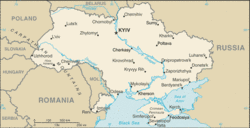Welcome to the Virtual Education Wiki ~ Open Education Wiki
Ukraine: Difference between revisions
(→Ukraine in a nutshell: added more on language) |
|||
| Line 20: | Line 20: | ||
Some 77.8 percent of the population are ethnic Ukrainians, with sizable minorities of Russians, Belarusians and Romanians. | Some 77.8 percent of the population are ethnic Ukrainians, with sizable minorities of Russians, Belarusians and Romanians. | ||
The Ukrainian language is the only official language in Ukraine, but Russian is also widely spoken. | The Ukrainian language is the only official language in Ukraine, but Russian is also widely spoken, especially in eastern and southern Ukraine. According to the 2001 census, 67.5 percent of the population declared Ukrainian as their native language and 29.6 percent declared Russian. Most native Ukrainian speakers know Russian as a second language. | ||
These details result in a significant difference across different survey results, as even a small restating of a question switches responses of a significant group of people. Ukrainian is mainly spoken in western and central Ukraine. In western Ukraine, Ukrainian is also the dominant language in cities (such as Lviv). In central Ukraine, Ukrainian and Russian are both equally used in cities, with Russian being more common in Kiev, while Ukrainian is the dominant language in rural communities. In eastern and southern Ukraine, Russian is primarily used in cities, and Ukrainian is used in rural areas. | |||
According to the Constitution of the Autonomous Republic of Crimea, Ukrainian is the only state language of the republic. However, the republic's constitution specifically recognises Russian as the language of the majority of its population and guarantees its usage "in all spheres of public life". Similarly, the Crimean Tatar language (the language of 12 percent of population of Crimea) is guaranteed a special state protection as well as the "languages of other ethnicities". Russian speakers constitute an overwhelming majority of the Crimean population (77 percent), with Ukrainian speakers comprising just 10.1 percent, and Crimean Tatar speakers 11.4 percent. But in everyday life the majority of Crimean Tatars and Ukrainians in Crimea use Russian. | |||
The dominant religion in the country is Eastern Orthodox Christianity, which has heavily influenced Ukrainian architecture, literature and music. | The dominant religion in the country is Eastern Orthodox Christianity, which has heavily influenced Ukrainian architecture, literature and music. | ||
Revision as of 14:21, 4 February 2010
Partners situated in Ukraine
None.
Ukraine in a nutshell
Ukraine (Ukrainian: Україна, transliterated: Ukrayina) is a country in Eastern Europe. It is bordered by Russia to the east; Belarus to the north; Poland, Slovakia, and Hungary to the west; Romania and Moldova to the southwest; and the Black Sea and Sea of Azov to the south.
The population of Ukraine is just over 46 million.
The city of Kiev (Kyiv) is both the capital and the largest city of Ukraine.
Ukraine is a unitary state composed of 24 oblasts (provinces), one autonomous republic (Crimea), and two cities with special status: Kiev, its capital, and Sevastopol, which houses the Russian Black Sea Fleet under a leasing agreement.
Ukraine is a republic under a semi-presidential system with separate legislative, executive, and judicial branches. Since the collapse of the Soviet Union, Ukraine continues to maintain the second largest military in Europe, after that of Russia.

Some 77.8 percent of the population are ethnic Ukrainians, with sizable minorities of Russians, Belarusians and Romanians.
The Ukrainian language is the only official language in Ukraine, but Russian is also widely spoken, especially in eastern and southern Ukraine. According to the 2001 census, 67.5 percent of the population declared Ukrainian as their native language and 29.6 percent declared Russian. Most native Ukrainian speakers know Russian as a second language.
These details result in a significant difference across different survey results, as even a small restating of a question switches responses of a significant group of people. Ukrainian is mainly spoken in western and central Ukraine. In western Ukraine, Ukrainian is also the dominant language in cities (such as Lviv). In central Ukraine, Ukrainian and Russian are both equally used in cities, with Russian being more common in Kiev, while Ukrainian is the dominant language in rural communities. In eastern and southern Ukraine, Russian is primarily used in cities, and Ukrainian is used in rural areas.
According to the Constitution of the Autonomous Republic of Crimea, Ukrainian is the only state language of the republic. However, the republic's constitution specifically recognises Russian as the language of the majority of its population and guarantees its usage "in all spheres of public life". Similarly, the Crimean Tatar language (the language of 12 percent of population of Crimea) is guaranteed a special state protection as well as the "languages of other ethnicities". Russian speakers constitute an overwhelming majority of the Crimean population (77 percent), with Ukrainian speakers comprising just 10.1 percent, and Crimean Tatar speakers 11.4 percent. But in everyday life the majority of Crimean Tatars and Ukrainians in Crimea use Russian.
The dominant religion in the country is Eastern Orthodox Christianity, which has heavily influenced Ukrainian architecture, literature and music.
The World Bank classifies Ukraine as a middle-income state. Significant issues include underdeveloped infrastructure and transportation, corruption and bureaucracy. In 2007 the Ukrainian stock market recorded the second highest growth in the world of 130 percent. Growing sectors of the Ukrainian economy include the information technology (IT) market, which topped all other Central and Eastern European countries in 2007, growing some 40 percent.
Ukraine education policy
Ukraine education system
Higher education
Universities in Ukraine
Polytechnics in Ukraine
Higher education reform
The Bologna Process
Administration and finance
Quality assurance
Ukraine HEIs in the information society
Towards the information society
Information society strategy
Virtual Campuses in HE
Interesting Virtual Campus Initiatives
Interesting Programmes
See:
Re.ViCa Case-study
None.